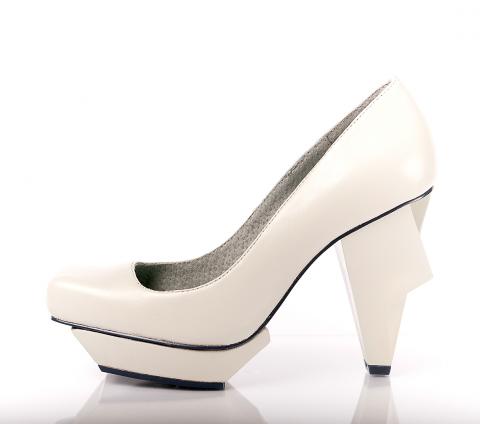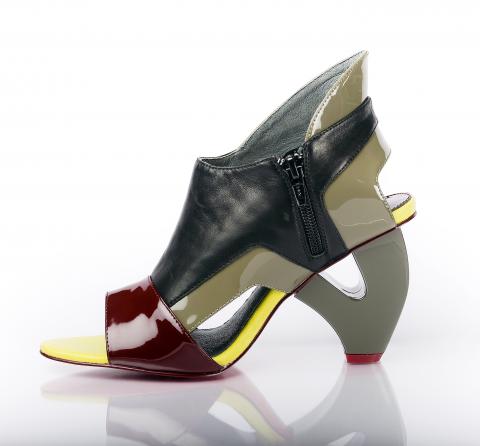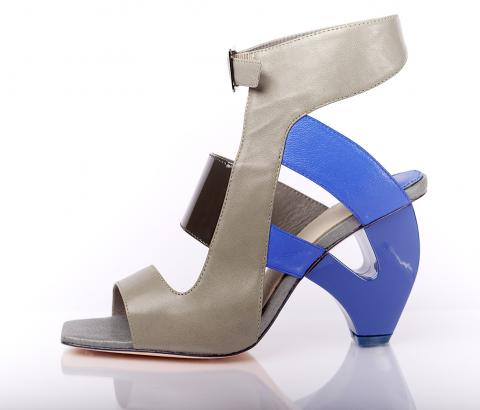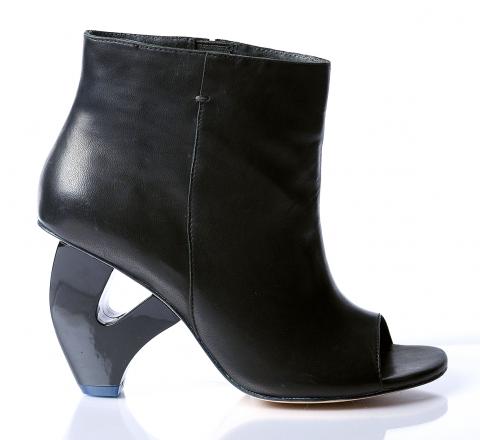With just two collections so far, Heavy Machine’s industrial-inspired shoes have caught the eyes of fashion insiders.
Sandals and pumps by the Taiwanese brand, which was launched in 2009, feature sculptural details like sharply angled resin heels and soaring platform soles. Feminine color combinations in jewel and sherbet tones offset the futuristic designs.
The brand has been written up in Ars Sutoria, a leading trade publication, US Glamour, Japan’s So-en, and appeared on influential fashion blogs Style Bubble (www.stylebubble.co.uk) and Kingdom of Style (www.kingdomofstyle.net).

Photo courtesy of Heavy Machine
Heavy Machine designers Yoyo Pan (潘國瑤) and Michelle Wu (吳怡慧) met four years ago. Both studied fashion design abroad, Pan at the Royal Melbourne Institute of Technology and Wu at the Fashion Institute of Technology in New York City. From the beginning of their friendship, the two talked about launching a line of shoes different from what was then available on the market.
“We liked shoes that are unusual and hard to find,” Wu says. “We wanted them to be completely unlike any other shoes.”
At the beginning, the two had to tone down some of their more exaggerated designs in order to make them manufacturable.

Photo courtesy of Heavy Machine
“The footwear makers said they couldn’t actually make it or else the shoes would turn out completely different from our sketches,” Wu says.
“At first we didn’t really understand the construction of shoes and just designed what we thought was cute,” Pan says. She enrolled at the Footwear and Recreation Technology Research Institute (台中鞋技中心) in Taichung, where she studied shoe engineering.
The duo look up to designers who are known for their conceptual creations, including Martin Margiela, Nicolas Ghesquiere and Helmut Lang, and their influence can be seen in Heavy Machine’s innovative designs.

Photo courtesy of Heavy Machine
But Pan and Wu’s brand has also earned kudos for its wearability. In one post, blogger Susanna Lau of Style Bubble pronounced a pair of shoes from Heavy Machine’s first collection “definitely comfortable” after a day spent walking around in them.
High-heeled sandals and pumps are balanced with a curved platform sole to stabilize the foot while walking. Heels are placed to support the weight of the body.
“I’m not very good at wearing high-heeled shoes. I find a lot of them uncomfortable and hard to walk in,” Wu says. “I want to make shoes that I can at least wear myself.”

Photo courtesy of Heavy Machine
From the start, Pan and Wu pursued an international market for Heavy Machine, attending trade shows including Designers and Agents (D&A) in New York City and Tranoi in Paris. Their shoes are currently sold in 10 countries, including Taiwan, Kuwait, Australia, the Netherlands, Japan and Hong Kong.
“We don’t have a target customer in mind,” Wu says. “Just as long as they are women — or men.”
“Yes, as long as they are people,” Pan adds.
For a list of stores, visit www.heavymachinedesign.com

This is the year that the demographic crisis will begin to impact people’s lives. This will create pressures on treatment and hiring of foreigners. Regardless of whatever technological breakthroughs happen, the real value will come from digesting and productively applying existing technologies in new and creative ways. INTRODUCING BASIC SERVICES BREAKDOWNS At some point soon, we will begin to witness a breakdown in basic services. Initially, it will be limited and sporadic, but the frequency and newsworthiness of the incidents will only continue to accelerate dramatically in the coming years. Here in central Taiwan, many basic services are severely understaffed, and

Jan. 5 to Jan. 11 Of the more than 3,000km of sugar railway that once criss-crossed central and southern Taiwan, just 16.1km remain in operation today. By the time Dafydd Fell began photographing the network in earnest in 1994, it was already well past its heyday. The system had been significantly cut back, leaving behind abandoned stations, rusting rolling stock and crumbling facilities. This reduction continued during the five years of his documentation, adding urgency to his task. As passenger services had already ceased by then, Fell had to wait for the sugarcane harvest season each year, which typically ran from

It is a soulful folk song, filled with feeling and history: A love-stricken young man tells God about his hopes and dreams of happiness. Generations of Uighurs, the Turkic ethnic minority in China’s Xinjiang region, have played it at parties and weddings. But today, if they download it, play it or share it online, they risk ending up in prison. Besh pede, a popular Uighur folk ballad, is among dozens of Uighur-language songs that have been deemed “problematic” by Xinjiang authorities, according to a recording of a meeting held by police and other local officials in the historic city of Kashgar in

It’s a good thing that 2025 is over. Yes, I fully expect we will look back on the year with nostalgia, once we have experienced this year and 2027. Traditionally at New Years much discourse is devoted to discussing what happened the previous year. Let’s have a look at what didn’t happen. Many bad things did not happen. The People’s Republic of China (PRC) did not attack Taiwan. We didn’t have a massive, destructive earthquake or drought. We didn’t have a major human pandemic. No widespread unemployment or other destructive social events. Nothing serious was done about Taiwan’s swelling birth rate catastrophe.